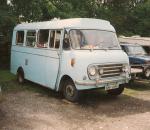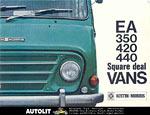Austin » EA
The EA (easy access) van was introduced to replace the LD series, and as it was launched following the Leyland takeover in 1968, BLMC’s branding policy dictated that it initally wore the BMC badge. With a payload of 1½ tons (30cwt), the van could be ordered with standard or long bodywork (both built on the same wheelbase), offering loadspace capacities of 274 cu ft and 322 cu ft respectively.
In 1970 the EA was rebranded as a Leyland or Austin Morris vehicle, and the range was also revised. A new, long-wheelbase version was introduced, meaning that the EA now offered a significantly larger loadspace than its predecessor – the LD – had done, being available with capacities of 322 cu ft (short wheelbase) or 390 cu ft (long wheelbase). This was accompanied by an overall increase in payload, which now ranged from 1½ to 2 tons. It could also be ordered in chassis-cab form.
Leyland never made any bones about the EA’s utilitarian nature, promoting it variously as “a box on wheels” or as being “plain, practicable and packed with power”, which incidentally was provided by 2½-litre, OHV petrol (70bhp) and diesel (58bhp) engines. Sadly, much of the goodwill which had been earned by the LD evapotrated, as the EA was beset by build quality and reliabilty issues. It would nevertheless become a familiar sight on Britiain’s roads during the 1970s, and also achieved some sales success in continental Europe. It was eventually replaced in 1984 by the larger versions of the Sherpa.





